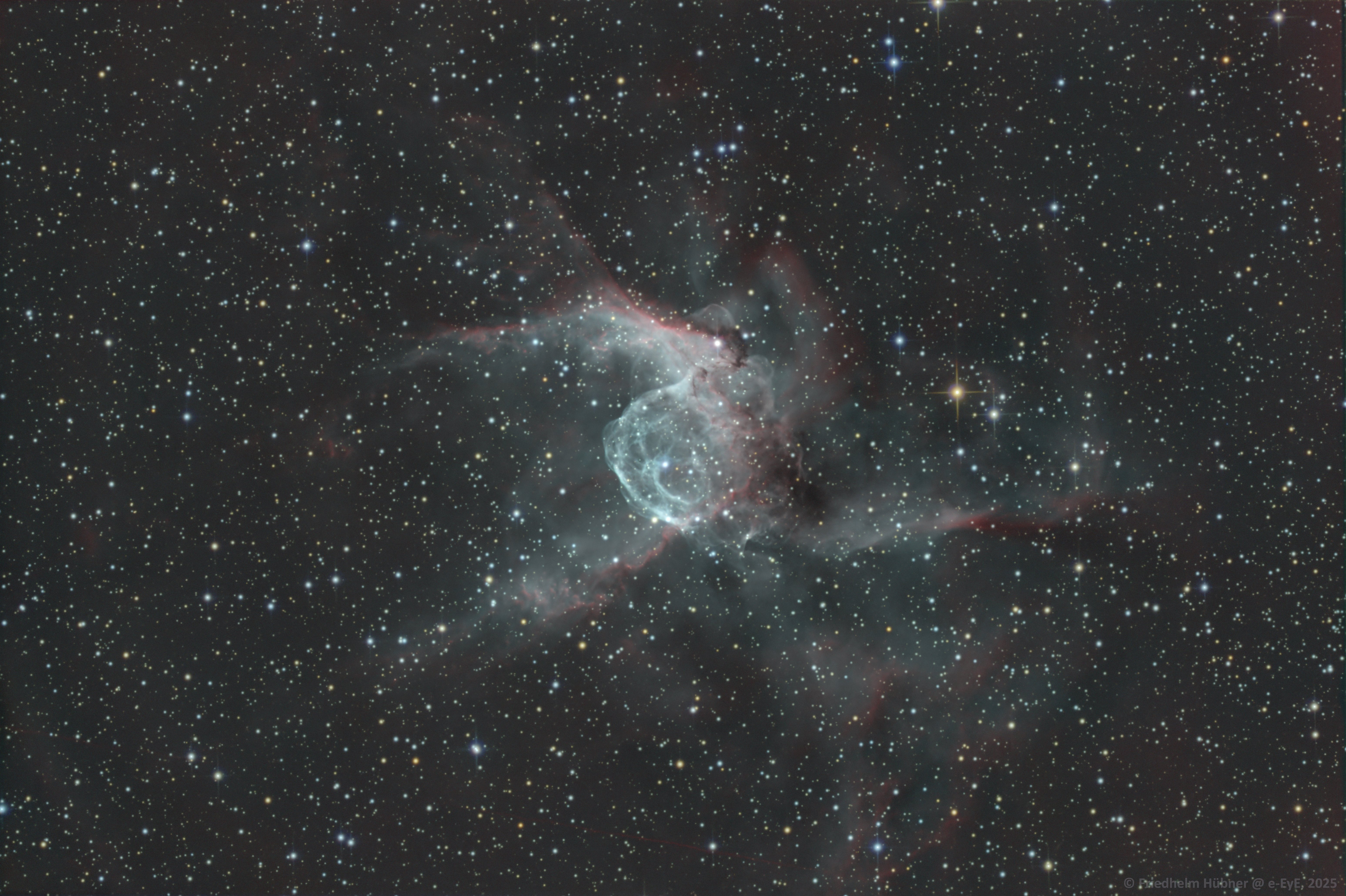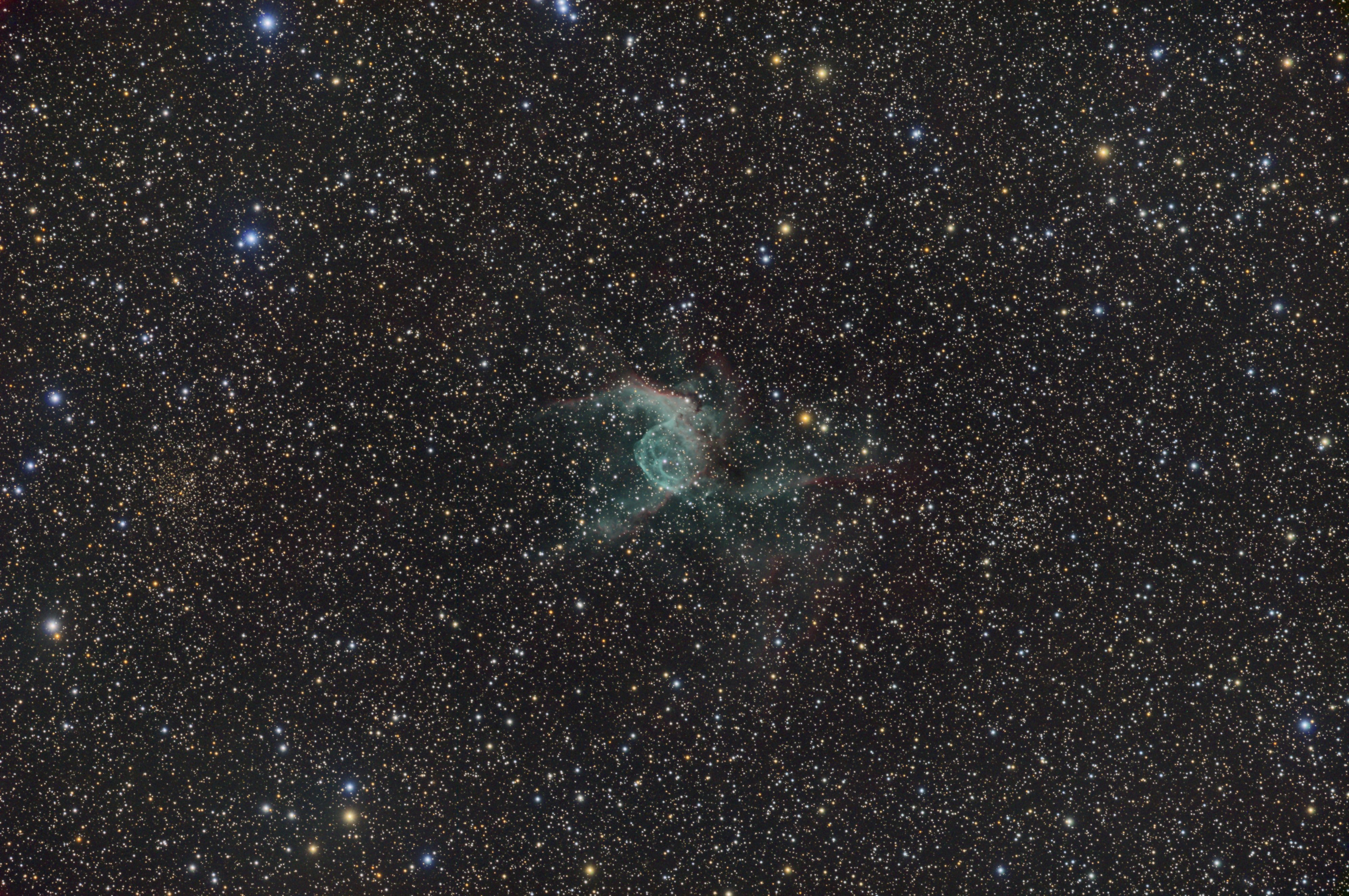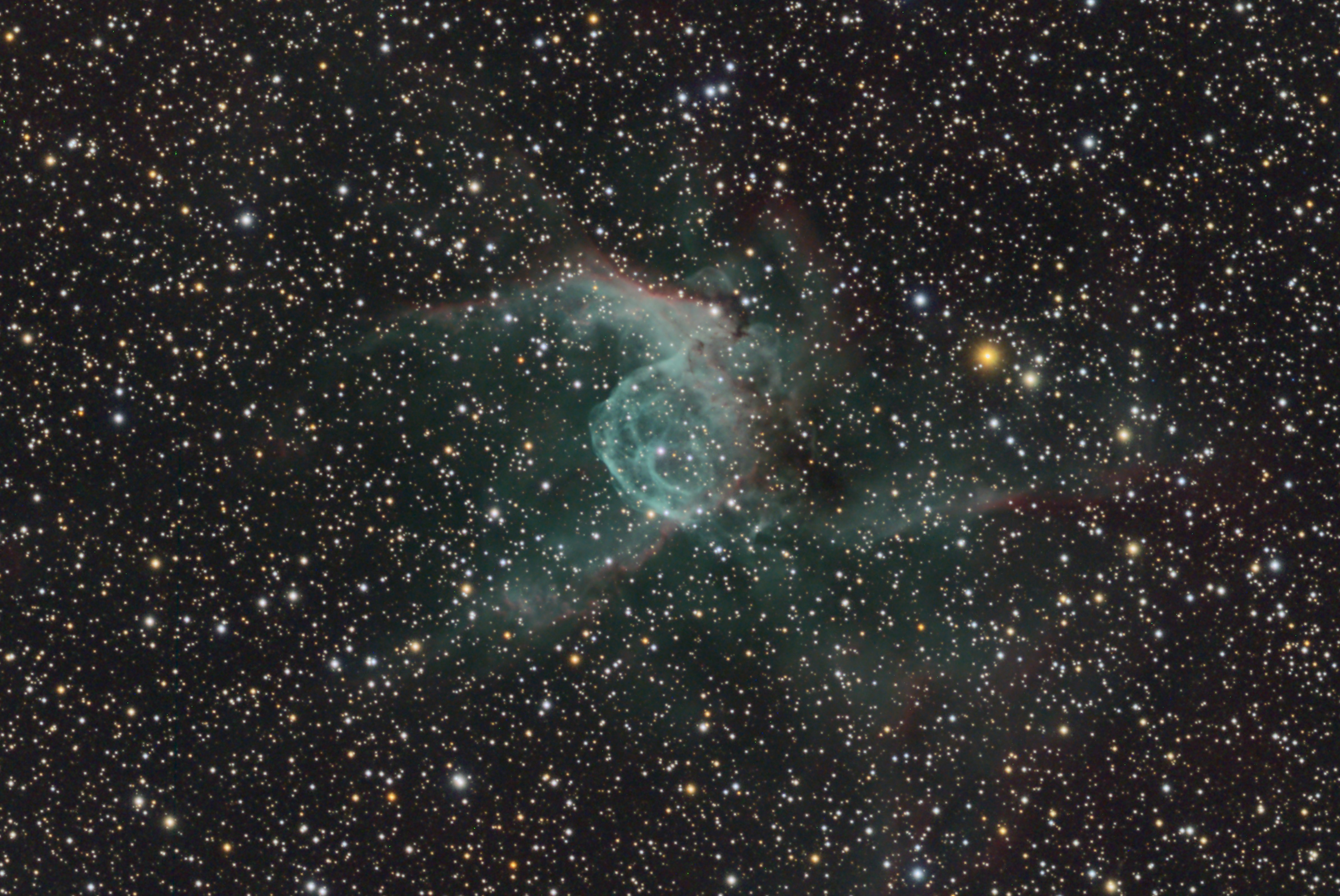|
NGC 2359 (CMa)

Click on the image for a larger version
| Date/Site: |
14., 15., 17., 18., 30. and 31. January 2025, e-EyE |
Exposure/
Filter: |
R: 28 x 180 seconds,
G: 23 x 180 seconds,
B: 24 x 180 seconds,
Hα: 70 x 300 seconds,
O3: 67 x 300 seconds (-5°C) |
Camera/
Optics/
Instrument: |
ASI 2600MM Pro with Astronomik Type 2c-filter on 400mm f/5 Newton with 2" TS Comacorrector on AP1200 GTO |
|
Data acquired remotely using N.I.N.A.,
Off-Axis-Guiding with ASI120,
Focusing with Microtouch,
Calibration with MaximDL 6, processing in PixInsight 1.8 using BXT and GraXpert |
A Wolf-Rayet-star produces a bubble of hot gas behind a dense molecular cloud. NGC 2359 was adopted as „my“ object during my years in Munich. With a 12“-Dobson and O3 or UHC-filters ander a dark sky a lot of detail is visible. The bubble is plainly visible and even appears mottled. The edge of the gas and dust cloud in front of the emerging shell sharply turns upwards on both sides. For us it always looked more like a snail with its house rather than a northern warrior's helmet.
It was an obligation to image my object under the new circumstances.
NGC 2359 (CMa), 2014, Hacienda los Andes

Click on the image for a larger version
| Date/Site: |
3. Februaryy 2014, Astrofarm at the Hacienda los Andes, Chile |
Exposure/
Filter |
BR: each 5 x 600 seconds,
G: 6 x 600 seconds (-20°C) |
| Camera: |
SBIG STL11000 with Astronomik type II-filters |
Optics/
Instrument: |
Astro-Physics 175mm f/8 StarFire EDF triplet refractor with flattener on AP1200 GTO |
|
Guiding: Lodestar attached to a 61mm-finder,
focusing: Robofocus and FocusMax,
image acquisition: CCD-Commander and MaximDL 5,
calibration and processing: PixInsight 1.8 |
Only during my last observing night in Chile guiding-issues ruined several of the frames for NGC 2359. I used the wrong parameters for the guidingstars in CCD-Commander. So in the field of view in the middle of the milkyway the Lodestar found mostly saturated stars, unsuitable for guiding. And the star chosen in the end was too weak. I had to scrap quite a lot of frames and the night was advanced. And for the first time I had chosen relatively short exposures, as I wanted to get more frames ... Still I am quite happy with the result.
NGC 2359 (CMa), 2014, Hacienda los Andes

Click on the image for a larger version
| Date/Site: |
2. Februaryyy 2014, Astrofarm at the Hacienda los Andes, Chile |
Exposure/
Filter |
O3: 9 x 1200 seconds (-20°C)
RGB from the STL11000 with the AP-refractor |
| Camera: |
FLI PL16070, Astrodon O3-filter (5nm) |
Optics/
Instrument: |
RCOS 14,5" f/9 RC with flattener on AP1200 GTO |
|
off-axis-guiding, Astrodon MOAG with Lodestar
focusing mit FocusMax,
focusing: Robofocus and FocusMax,
image acquisition: MaximDL 5,
calibration and processing: PixInsight 1.8 |
It was a great pleasure to use Daniel's 14,5" f9 RC together with the new FLI PL16070. This modern camera is really fast (which makes focusing a breeze) and still quite noise-free. At first I was really worried about guiding at 3.3 meters focal lenght but after the first 10-minutes frame I immediately changed to 20-minutes frames.
The O3-signal was combined with the RGB-signal from the corresponding part of the image acquired with the refractor.
An earlier image:
NGC 2359 (CMa), 2009

Click on the image for a larger version
| Date/Site: |
March 9., 2009, AAR-observatory in Presberg |
Exposure/
Filter: |
L: 3 x 10 minutes,
B: 3 x 5 minutes, G: 3 x 5 minutes, R: 2 x 5 minutes, (-25°C) |
| Camera: |
SBIG ST10XME with CFW9 and SBIG LRGB-filters |
Optics/
Instrument: |
26cm-Newton on Gemini 41 Observatory |
|
Focusing with Robofocus |
|
Darks, flats, deblooming, alignment and stacking: MaximDL 5,
Levels and curves: Photoshop CS3. |
In the beginning conditions were quite good with a strong easterly wind, limiting magnitude 5.8 to 6.0m, -7°C. From 23:30 from the south a cloud bank moved in, which should not have reached us at all. At 1:00 conditions forced me to quit.
The winter's milky way already was in the southwest when I started my sequence of exposures. The last red-frame was lost, as the object already sank very deep and the camera lost the guiding star. Because of the low declination seeing deteriorated significantly and the stars appear comparatively bloated. Autoguiding was quite busy compared to the nights before.
|



